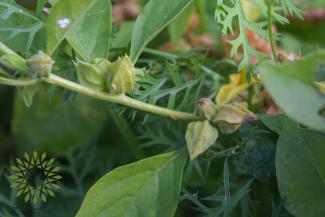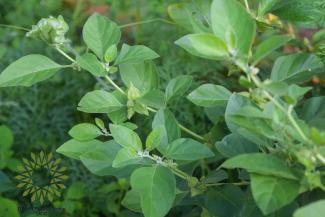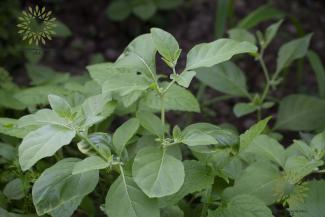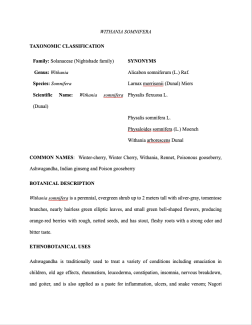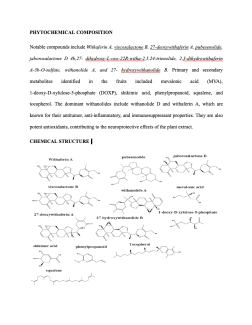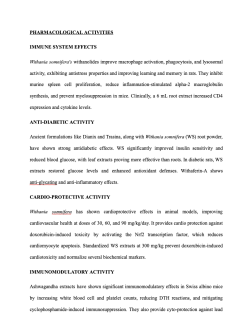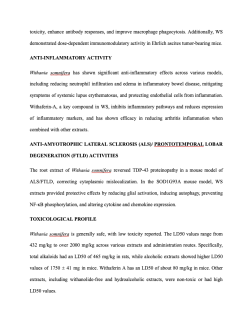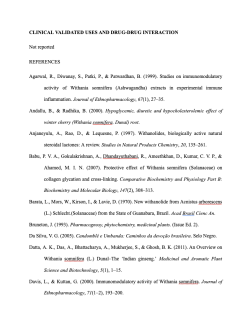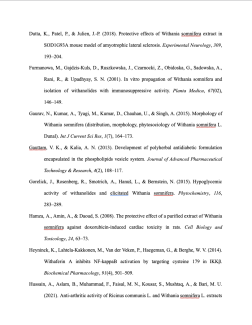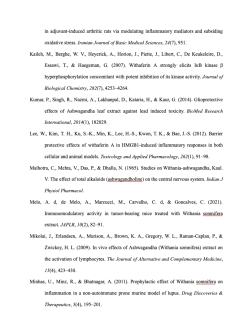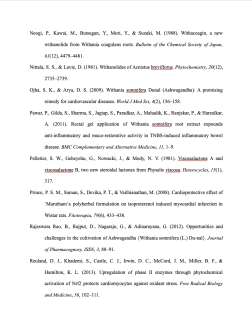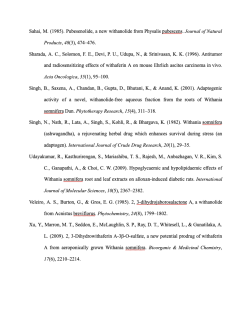WITHANIA SOMNIFERA
TAXONOMIC CLASSIFICATION
|
|
|
|
|
|
|
|
|
|
|
|
|
|
|
|
|
|
|
|
|
COMMON NAMES: Winter-cherry, Winter Cherry, Withania, Rennet, Poisonous gooseberry, Ashwagandha, Indian ginseng and Poison gooseberry
BOTANICAL DESCRIPTION
Withania somnifera is a perennial, evergreen shrub up to 2 meters tall with silver-gray, tomentose branches, nearly hairless green elliptic leaves, and small green bell-shaped flowers, producing orange-red berries with rough, netted seeds, and has stout, fleshy roots with a strong odor and bitter taste.
ETHNOBOTANICAL USES
Ashwagandha is traditionally used to treat a variety of conditions including emaciation in children, old age effects, rheumatism, leucoderma, constipation, insomnia, nervous breakdown, and goiter, and is also applied as a paste for inflammation, ulcers, and snake venom; Nagori Ashwagandha is considered the most potent, with the highest benefits derived from fresh powder.
PHYTOCHEMICAL COMPOSITION
Notable compounds include Withaferin A, viscosalactone B, 27-deoxywithaferin A, pubesenolide, jaborosalactone D 4b,27- dihydroxy-L-oxo-22R-witha-2,5,24-trienolide, 2,3-dihydrowithaferin A-3b-O-sulfate, withanolide A, and 27- hydroxywithanolide B. Primary and secondary metabolites identified in the fruits included mevalonic acid (MVA), 1-deoxy-D-xylulose-5-phosphate (DOXP), shikimic acid, phenylpropanoid, squalene, and tocopherol. The dominant withanolides include withanolide D and withaferin A, which are known for their antitumor, anti-inflammatory, and immunosuppressant properties. They are also potent antioxidants, contributing to the neuroprotective effects of the plant extract.
CHEMICAL STRUCTURE
PHARMACOLOGICAL ACTIVITIES
IMMUNE SYSTEM EFFECTS
Withania somnifera's withanolides improve macrophage activation, phagocytosis, and lysosomal activity, exhibiting antistress properties and improving learning and memory in rats. They inhibit murine spleen cell proliferation, reduce inflammation-stimulated alpha-2 macroglobulin synthesis, and prevent myelosuppression in mice. Clinically, a 6 mL root extract increased CD4 expression and cytokine levels.
ANTI-DIABETIC ACTIVITY
Ancient formulations like Dianix and Trasina, along with Withania somnifera (WS) root powder, have shown strong antidiabetic effects. WS significantly improved insulin sensitivity and reduced blood glucose, with leaf extracts proving more effective than roots. In diabetic rats, WS extracts restored glucose levels and enhanced antioxidant defenses. Withaferin-A shows anti-glycating and anti-inflammatory effects.
CARDIO-PROTECTIVE ACTIVITY
Withania somnifera has shown cardioprotective effects in animal models, improving cardiovascular health at doses of 30, 60, and 90 mg/kg/day. It provides cardio protection against doxorubicin-induced toxicity by activating the Nrf2 transcription factor, which reduces cardiomyocyte apoptosis. Standardized WS extracts at 300 mg/kg prevent doxorubicin-induced cardiotoxicity and normalize several biochemical markers.
IMMUNOMODULATORY ACTIVITY
Ashwagandha extracts have shown significant immunomodulatory effects in Swiss albino mice by increasing white blood cell and platelet counts, reducing DTH reactions, and mitigating cyclophosphamide-induced immunosuppression. They also provide cyto-protection against lead toxicity, enhance antibody responses, and improve macrophage phagocytosis. Additionally, WS demonstrated dose-dependent immunomodulatory activity in Ehrlich ascites tumor-bearing mice.
ANTI-INFLAMMATORY ACTIVITY
Withania somnifera has shown significant anti-inflammatory effects across various models, including reducing neutrophil infiltration and edema in inflammatory bowel disease, mitigating symptoms of systemic lupus erythematosus, and protecting endothelial cells from inflammation. Withaferin-A, a key compound in WS, inhibits inflammatory pathways and reduces expression of inflammatory markers, and has shown efficacy in reducing arthritis inflammation when combined with other extracts.
ANTI-AMYOTROPHIC LATERAL SCLEROSIS (ALS)/ PRONTOTEMPORAL LOBAR DEGENERATION (FTLD) ACTIVITIES
The root extract of Withania somnifera reversed TDP-43 proteinopathy in a mouse model of ALS/FTLD, correcting cytoplasmic mislocalization. In the SOD1G93A mouse model, WS extracts provided protective effects by reducing glial activation, inducing autophagy, preventing NF-κB phosphorylation, and altering cytokine and chemokine expression.
TOXICOLOGICAL PROFILE
Withania somnifera is generally safe, with low toxicity reported. The LD50 values range from 432 mg/kg to over 2000 mg/kg across various extracts and administration routes. Specifically, total alkaloids had an LD50 of 465 mg/kg in rats, while alcoholic extracts showed higher LD50 values of 1750 ± 41 mg in mice. Withaferin A has an LD50 of about 80 mg/kg in mice. Other extracts, including withanolide-free and hydroalcoholic extracts, were non-toxic or had high LD50 values.
CLINICAL VALIDATED USES AND DRUG-DRUG INTERACTION
Not reported
REFERENCES
Agarwal, R., Diwanay, S., Patki, P., & Patwardhan, B. (1999). Studies on immunomodulatory activity of Withania somnifera (Ashwagandha) extracts in experimental immune inflammation. Journal of Ethnopharmacology, 67(1), 27–35.
Andallu, B., & Radhika, B. (2000). Hypoglycemic, diuretic and hypocholesterolemic effect of winter cherry (Withania somnifera, Dunal) root.
Anjaneyulu, A., Rao, D., & Lequesne, P. (1997). Withanolides, biologically active natural steroidal lactones: A review. Studies in Natural Products Chemistry, 20, 135–261.
Babu, P. V. A., Gokulakrishnan, A., Dhandayuthabani, R., Ameethkhan, D., Kumar, C. V. P., & Ahamed, M. I. N. (2007). Protective effect of Withania somnifera (Solanaceae) on collagen glycation and cross-linking. Comparative Biochemistry and Physiology Part B: Biochemistry and Molecular Biology, 147(2), 308–313.
Barata, L., Mors, W., Kirson, I., & Lavie, D. (1970). New withanolide from Acnistus arborescens (L.) Schlecht.(Solanaceae) from the State of Guanabara, Brazil. Acad Brasil Cienc An.
Bruneton, J. (1993). Pharmacognosy, phytochemistry, medicinal plants. (Issue Ed. 2).
Da Silva, V. G. (2005). Candomblé e Umbanda: Caminhos da devoção brasileira. Selo Negro.
Datta, A. K., Das, A., Bhattacharya, A., Mukherjee, S., & Ghosh, B. K. (2011). An Overview on Withania somnifera (L.) Dunal–The ‘Indian ginseng.’ Medicinal and Aromatic Plant Science and Biotechnology, 5(1), 1–15.
Davis, L., & Kuttan, G. (2000). Immunomodulatory activity of Withania somnifera. Journal of Ethnopharmacology, 71(1–2), 193–200.
Dutta, K., Patel, P., & Julien, J.-P. (2018). Protective effects of Withania somnifera extract in SOD1G93A mouse model of amyotrophic lateral sclerosis. Experimental Neurology, 309, 193–204.
Furmanowa, M., Gajdzis-Kuls, D., Ruszkowska, J., Czarnocki, Z., Obidoska, G., Sadowska, A., Rani, R., & Upadhyay, S. N. (2001). In vitro propagation of Withania somnifera and isolation of withanolides with immunosuppressive activity. Planta Medica, 67(02), 146–149.
Gaurav, N., Kumar, A., Tyagi, M., Kumar, D., Chauhan, U., & Singh, A. (2015). Morphology of Withania somnifera (distribution, morphology, phytosociology of Withania somnifera L. Dunal). Int J Current Sci Res, 1(7), 164–173.
Gauttam, V. K., & Kalia, A. N. (2013). Development of polyherbal antidiabetic formulation encapsulated in the phospholipids vesicle system. Journal of Advanced Pharmaceutical Technology & Research, 4(2), 108–117.
Gorelick, J., Rosenberg, R., Smotrich, A., Hanuš, L., & Bernstein, N. (2015). Hypoglycemic activity of withanolides and elicitated Withania somnifera. Phytochemistry, 116, 283–289.
Hamza, A., Amin, A., & Daoud, S. (2008). The protective effect of a purified extract of Withania somnifera against doxorubicin-induced cardiac toxicity in rats. Cell Biology and Toxicology, 24, 63–73.
Heyninck, K., Lahtela-Kakkonen, M., Van der Veken, P., Haegeman, G., & Berghe, W. V. (2014). Withaferin A inhibits NF-kappaB activation by targeting cysteine 179 in IKKβ. Biochemical Pharmacology, 91(4), 501–509.
Hussain, A., Aslam, B., Muhammad, F., Faisal, M. N., Kousar, S., Mushtaq, A., & Bari, M. U. (2021). Anti-arthritic activity of Ricinus communis L. and Withania somnifera L. extracts in adjuvant-induced arthritic rats via modulating inflammatory mediators and subsiding oxidative stress. Iranian Journal of Basic Medical Sciences, 24(7), 951.
Kaileh, M., Berghe, W. V., Heyerick, A., Horion, J., Piette, J., Libert, C., De Keukeleire, D., Essawi, T., & Haegeman, G. (2007). Withaferin A strongly elicits IκB kinase β hyperphosphorylation concomitant with potent inhibition of its kinase activity. Journal of Biological Chemistry, 282(7), 4253–4264.
Kumar, P., Singh, R., Nazmi, A., Lakhanpal, D., Kataria, H., & Kaur, G. (2014). Glioprotective effects of Ashwagandha leaf extract against lead induced toxicity. BioMed Research International, 2014(1), 182029.
Lee, W., Kim, T. H., Ku, S.-K., Min, K., Lee, H.-S., Kwon, T. K., & Bae, J.-S. (2012). Barrier protective effects of withaferin A in HMGB1-induced inflammatory responses in both cellular and animal models. Toxicology and Applied Pharmacology, 262(1), 91–98.
Malhotra, C., Mehta, V., Das, P., & Dhalla, N. (1965). Studies on Withania-ashwagandha, Kaul. V. The effect of total alkaloids (ashwagandholine) on the central nervous system. Indian J Physiol Pharmacol.
Melo, A. d, de Melo, A., Marcucci, M., Carvalho, C. d, & Goncalves, C. (2021). Immunomodulatory activity in tumor-bearing mice treated with Withania somnifera extract. JAPLR, 10(2), 82–91.
Mikolai, J., Erlandsen, A., Murison, A., Brown, K. A., Gregory, W. L., Raman-Caplan, P., & Zwickey, H. L. (2009). In vivo effects of Ashwagandha (Withania somnifera) extract on the activation of lymphocytes. The Journal of Alternative and Complementary Medicine, 15(4), 423–430.
Minhas, U., Minz, R., & Bhatnagar, A. (2011). Prophylactic effect of Withania somnifera on inflammation in a non-autoimmune prone murine model of lupus. Drug Discoveries & Therapeutics, 5(4), 195–201.
Neogi, P., Kawai, M., Butsugan, Y., Mori, Y., & Suzuki, M. (1988). Withacoagin, a new withanolide from Withania coagulans roots. Bulletin of the Chemical Society of Japan, 61(12), 4479–4481.
Nittala, S. S., & Lavie, D. (1981). Withanolides of Acnistus breviflorus. Phytochemistry, 20(12), 2735–2739.
Ojha, S. K., & Arya, D. S. (2009). Withania somnifera Dunal (Ashwagandha): A promising remedy for cardiovascular diseases. World J Med Sci, 4(2), 156–158.
Pawar, P., Gilda, S., Sharma, S., Jagtap, S., Paradkar, A., Mahadik, K., Ranjekar, P., & Harsulkar, A. (2011). Rectal gel application of Withania somnifera root extract expounds anti-inflammatory and muco-restorative activity in TNBS-induced inflammatory bowel disease. BMC Complementary and Alternative Medicine, 11, 1–9.
Pelletier, S. W., Gebeyehu, G., Nowacki, J., & Mody, N. V. (1981). Viscosalactone A and viscosalactone B, two new steroidal lactones from Physalis viscosa. Heterocycles, 15(1), 317.
Prince, P. S. M., Suman, S., Devika, P. T., & Vaithianathan, M. (2008). Cardioprotective effect of ‘Marutham’a polyherbal formulation on isoproterenol induced myocardial infarction in Wistar rats. Fitoterapia, 79(6), 433–438.
Rajeswara Rao, B., Rajput, D., Nagaraju, G., & Adinarayana, G. (2012). Opportunities and challenges in the cultivation of Ashwagandha {Withania somnifera (L.) Du-nal}. Journal of Pharmacognosy, ISSN, 3, 88–91.
Reuland, D. J., Khademi, S., Castle, C. J., Irwin, D. C., McCord, J. M., Miller, B. F., & Hamilton, K. L. (2013). Upregulation of phase II enzymes through phytochemical activation of Nrf2 protects cardiomyocytes against oxidant stress. Free Radical Biology and Medicine, 56, 102–111.
Sahai, M. (1985). Pubesenolide, a new withanolide from Physalis pubescens. Journal of Natural Products, 48(3), 474–476.
Sharada, A. C., Solomon, F. E., Devi, P. U., Udupa, N., & Srinivasan, K. K. (1996). Antitumor and radiosensitizing effects of withaferin A on mouse Ehrlich ascites carcinoma in vivo. Acta Oncologica, 35(1), 95–100.
Singh, B., Saxena, A., Chandan, B., Gupta, D., Bhutani, K., & Anand, K. (2001). Adaptogenic activity of a novel, withanolide‐free aqueous fraction from the roots of Withania somnifera Dun. Phytotherapy Research, 15(4), 311–318.
Singh, N., Nath, R., Lata, A., Singh, S., Kohli, R., & Bhargava, K. (1982). Withania somnifera (ashwagandha), a rejuvenating herbal drug which enhances survival during stress (an adaptogen). International Journal of Crude Drug Research, 20(1), 29–35.
Udayakumar, R., Kasthurirengan, S., Mariashibu, T. S., Rajesh, M., Anbazhagan, V. R., Kim, S. C., Ganapathi, A., & Choi, C. W. (2009). Hypoglycaemic and hypolipidaemic effects of Withania somnifera root and leaf extracts on alloxan-induced diabetic rats. International Journal of Molecular Sciences, 10(5), 2367–2382.
Veleiro, A. S., Burton, G., & Gros, E. G. (1985). 2, 3-dihydrojaborosalactone A, a withanolide from Acnistus breviflorus. Phytochemistry, 24(8), 1799–1802.
Xu, Y., Marron, M. T., Seddon, E., McLaughlin, S. P., Ray, D. T., Whitesell, L., & Gunatilaka, A. L. (2009). 2, 3-Dihydrowithaferin A-3β-O-sulfate, a new potential prodrug of withaferin A from aeroponically grown Withania somnifera. Bioorganic & Medicinal Chemistry, 17(6), 2210–2214.
INFORMATION, DATA AND PICTURES ARE COPYRIGHT OF DPHM, SCHOOL OF PHARMACY, UCC.


